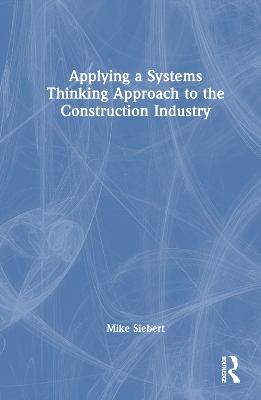
Applying a Systems Thinking Approach to the Construction Industry
Routledge (Verlag)
978-1-032-36618-0 (ISBN)
This book aims to shed light on why it is that so many well-meaning initiatives and government white papers have failed to have the expected impact in transforming the UK construction industry. Using the UK housing sector as a case study, Mike Siebert applies a Systems Thinking approach to tackling some of the shared 'Wicked Problems' faced by an industry that urgently needs to boost its productivity levels, build more sustainably and affordably, and generally improve its working practices.
In an accessible and easy to read style, Siebert challenges the overall decision making and problem-solving approach adopted by the industry and seeks to put Systems Thinking front and centre to consider the core issues from multiple perspectives. Initially outlining the key stakeholders and the drivers and barriers to change, he then introduces Systems Thinking and explains using numerous examples of known issues what this approach could achieve.
His central aim is to show how, if a Systems Thinking approach were to be applied to the UK housing industry’s problems, many of them could be resolved to the benefit of all the parties involved – government, housebuilders, material suppliers, the warranty industry, the design industry and the end users. These are shared problems, and they require shared solutions, but without first understanding these complex problems from the perspectives of all parties that need to benefit from the solutions being proposed, it is unlikely that those solutions will achieve the level of engagement needed for them to successfully meet their objectives.
Mike Siebert is a practising architect, active researcher and founder of Ecologic Homes Consultancy Ltd. He has advised Nottingham City Council, lectured and tutored at the University of Nottingham and Nottingham Trent Univerisy, and worked with the Construction Innovation Hub to help deliver the UK government’s latest initiatives aimed at transforming the construction industry, including the Platform Design Approach and the Value Toolkit.
Part I - What are we trying to do; What’s stopping us?; How could we approach it differently
Chapter 1 – Defining the Sectors
Chapter 2 – Drivers for Change: The government perspective on what the industry needs to do
Chapter 3 – Barriers to Change: The industry perspective on what the government needs to understand
Chapter 4 – The Methodology for Change
Part II - What ‘approaching it differently’ could achieve
Chapter 5 – Political Intervention: pushing the right buttons at the right time
Chapter 6 – Industry Intervention: changing the message to fit the audience
Chapter 7 – The Missing Tools: the tools we need, how to build them, and how to promote them
Chapter 8 – Applying these tools to solve the Housing Industry’s crisis
| Erscheinungsdatum | 21.10.2023 |
|---|---|
| Zusatzinfo | 6 Line drawings, color; 57 Halftones, color; 63 Illustrations, black and white |
| Verlagsort | London |
| Sprache | englisch |
| Maße | 156 x 234 mm |
| Gewicht | 680 g |
| Themenwelt | Naturwissenschaften ► Biologie ► Ökologie / Naturschutz |
| Sozialwissenschaften ► Soziologie | |
| Technik ► Architektur | |
| Technik ► Bauwesen | |
| ISBN-10 | 1-032-36618-4 / 1032366184 |
| ISBN-13 | 978-1-032-36618-0 / 9781032366180 |
| Zustand | Neuware |
| Informationen gemäß Produktsicherheitsverordnung (GPSR) | |
| Haben Sie eine Frage zum Produkt? |
aus dem Bereich


